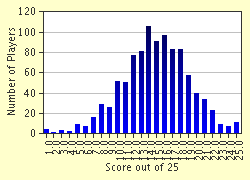Quiz Answer Key and Fun Facts
1. The Peloponnesian War began in 431 B.C. and was fought between what two cities?
2. The First Triumvirate was established in 60 B.C. by Julius Caesar, Marcus Licinius Crassus, and this Roman general and consul. He was one of Caesar's many enemies and his son-in-law,he became a ruler of Rome. Who was he?
3. Stonehenge is thought to have been built over a 1,500 year period. Approximately when is Stonehenge thought to have been started?
4. King Philip II of Macedonia was assassinated in 336 B.C. and was succeeded by his son. Who was he?
5. Which of the following is NOT one of the original Seven Wonders of the Ancient World?
6. Ancient forms of written communication in Mesopotamia were called what?
7. What structure is considered to be the oldest man-made building still standing?
8. What leader is responsible for creating the Persian Empire of the 6th century B.C.?
9. Which of these inhabited the Italian peninsula prior to the Romans?
10. Rome and Carthage fought each other in the Punic Wars. How many Punic Wars were there?
11. Who studied under Socrates?
12. The expression 'an eye for an eye' has come to symbolize the principle behind what code of laws?
13. Which is a Roman achievement in the 2nd century B.C. (200-101 B.C.)?
14. The Great Pyramid of Giza was built for which Egyptian ruler?
15. What nation was settled by the Amorites, a Semitic people from the Arabian peninsula, in 2100 B.C.?
16. Which ruler was the last Egyptian Pharaoh to hold part of Palestine?
17. Although the Japanese did not start writing their history until approx. 600 A.D., the first Japanese people came from the Korean peninsula in what century B.C.?
18. The Ch'in Dynasty ended in 207 B.C. and was followed by what Dynasty?
19. In Homer's The 'Odyssey', where is Odysseus trying to find his way home to?
20. Which Herod was in power during the time Jesus of Nazareth was born and also ordered the massacre of the innocents?
21. Which Pharaoh is believed to have been the Pharaoh during the Hebrew exodus from Egypt?
22. Before Julius Caesar became Consul for the second time, he was the Governor and military leader of what province?
23. Of the six vanished ancient Wonders of the World, which was the last to disappear?
24. The first Roman landing in Britain was led by Julius Caesar and happened in what year?
25. The Canaanites were one of the two main groups that made up the Phoenician civilization. Who was the other group?
Source: Author
Sprink1234
This quiz was reviewed by FunTrivia editor
bloomsby before going online.
Any errors found in FunTrivia content are routinely corrected through our feedback system.


